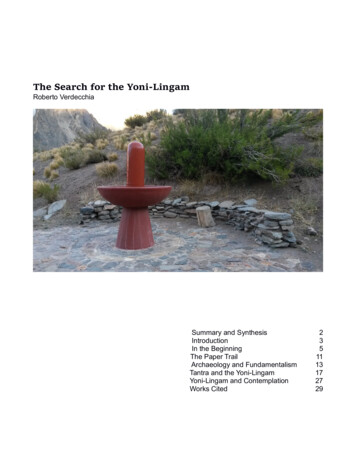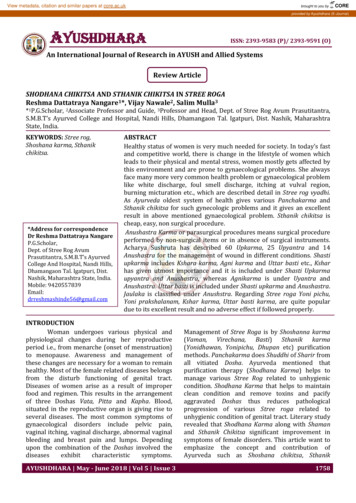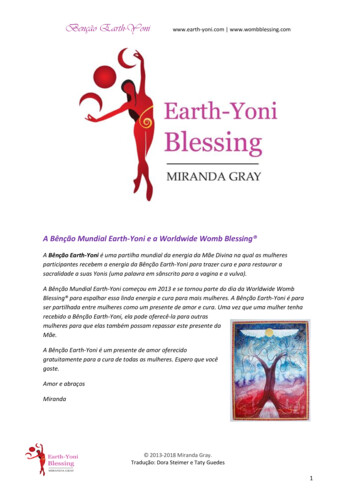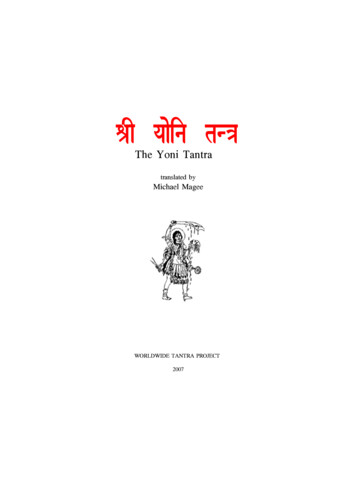
Transcription
The Search for the Yoni-LingamRoberto VerdecchiaSummary and SynthesisIntroductionIn the BeginningThe Paper TrailArchaeology and FundamentalismTantra and the Yoni-LingamYoni-Lingam and ContemplationWorks Cited2351113172729
2SUMMARYDriven by inspiring experiences while contemplating the yoni-lingam in my work in theEnergetic Discipline, I became curious to know when this allegorical representation firstappeared. Who had created it, or at least, in what context had it arisen? What I thoughtwould be a relatively straightforward Internet search turned out to be a highlyeducational foray into Indian history and the influence of fundamentalism onarchaeological interpretation. While some purport that the figure of the yoni-lingamdates back to the Indus Valley Civilization, I believe the object is not that old, and thatinstead it arose during the middle of the 1st millennium CE in the context of the Tantricmovement sweeping through India.SYNTHESISThe focus of this work is a search for the origins of the figure of the yoni-lingam, inspiredby experiences in the Energetic Discipline. More specifically, it seeks to answer thequestion of when the yoni-lingam first appeared, in what culture and/or context. For themost part the search was carried out bibliographically.
3INTRODUCTIONThe first time I saw the Yoni-Lingam I thought it was a very strange object. To me,it was certainly the most intriguing of all the symbols of the Disciplines. It didn't provokea feeling of satisfaction like the perfect sphere, it lacked the beauty and symmetry of thedorje, nor did it have the friendly familiarity of the salamander. It was almost beautiful,but not quite. But it was provocative–it made me look at it, to try to figure it out, to makesense of it, so I could finally say, "Ah, okay, I get it." In short, it was alluring.It was explained to me that the figure had to do with the union of Male andFemale, and that it came from India. As the sign for the Energetic Discipline, it was“related to certain Shaivite and Tantric lines.” 1 In my home city, the shops of Little Indiawere full of them.In a particular moment of my work in the Energetic Discipline, I began a practiceof contemplating the yoni-lingam. I would try to see it in a new way, to comprehend itmore deeply, to “enter” into it. And on some occasions, it seemed to speak to me, toreveal profound truths related to the union of Male and Female. So in time I becamecurious to know who (if anyone in particular) had created it—because whoever theywere, they must have been very wise to be able to synthesize and transmit so muchwisdom in such a simple object. And if no one person had created it, then when did itfirst appear?1 Silo, “Las Cuatro Disciplinas”, 3.
4I didn’t think it was a very complicated question. But to my surprise, Internetsearches for “earliest example of the yoni-lingam” turned up nothing, or almost alwaysended up focusing solely on the Linga. Indeed, if one researches the history of the lingaform, one finds a cornucopia of phallic objects across time and in civilizations aroundthe world. And if one looks specifically at historical examples of linga in India, there areclear ancient examples. One of the oldest continuously worshipped linga forms can betraced to the temple of Gudimallam, dating from about the 3rd century BCE 2. This lingais 1.5 metres high, carved in stone, and contains a slightly smaller image of Siva withinit. It is clearly a sacred form sculpted for the purpose of worship, and it is clearly just alinga (because sometimes a linga is just a linga):It is notable that unlike many later lingas, the Gudimallam example isnot set into a yoni, the vulva-shaped female symbol of power (thefeminine version of the linga), but is merely socketed into two circularstone elements. When the yoni is depicted in later sculptures, it isusually carved from the same piece of stone as the linga and thus actsas a base from which the linga rises.3Linga, linga everywhere, and prominently on display (ain’t that always the way?),but no such definitive examples existed regarding the oldest known yoni-lingam.Of course, the allegorical representation of the yoni-lingam, the linga within the2 Doniger, The Hindus, 22.3 Blurton, Hindu Art, 81.
5yoni, is not the same as the linga alone, or even the yoni alone. In India, one of the mostimportant pilgrimage sites—visited by millions of people each year—is an undergroundrock fissure below the Kamakhya Temple in Assam, worshipped as a sacred yoni form.But it is not a yoni-lingam, with the clear co-presence of male-female union.So began my research. It became a long and thoroughly entertaining trip throughthe history of India and then the rather nebulous history of Tantra, with some surprisingdetours into archaeological method, historiography, and Hindu fundamentalism alongthe way. In the end, I can only say that the origins of the yoni-lingam are still not clear,but they are becoming more so. But of course, the story is not over yet (is it ever?).IN THE BEGINNINGSince I didn't know where else to start looking, I thought that starting at thebeginning of Indian civilization was appropriate. The Indus Valley Civilization (orsometimes, Harappan Civilization), went through various stages from about 3300-1300BCE. At first, I found no traces of the yoni-lingam there, although intriguing objects havebeen unearthed in excavations at various sites, some of which may even refer to yogicpractices. The most famous of these is likely the figure of the "Siva Pashupati", anengraving of what appears to be a man wearing a horned head-dress, sitting in a crosslegged, meditative pose.Sir John Marshall, the chief archaeologist of the ancient city of Mohenjo-darowhere the engraving was found, made the link with Siva in his Excavation report:There appears at Mohenjo-daro a male god, who is recognizable atonce as a prototype of the historic Siva. . . . The God, who is three-
6faced, is seated on a low Indian throne in a typical attitude of Yoga,with legs bent double beneath him, heel to heel, and toes turneddownwards. His arms are outstretched, his hands, with thumbs to front,resting on his knees. From wrist to shoulder the arms are covered withbangles, eight smaller and three larger; over his breast is a triangularpectoral or perhaps a series of necklaces or torques, like those on thelater class of Goddess figurines from Baluchistan; and round his waista double band. The lower limbs are bare and the phallus(urdhvamedhra) seemingly exposed, but it is possible that whatappears to be the phallus is in reality the end of the waistband.Crowning his head is a pair of horns meeting in a tall head-dress. Toeither side of the god are four animals, an elephant and tiger on hisproper right, a rhinoceros and buffalo on his left. . . .The second feature of this pre-Aryan god that links him with thehistoric Siva is his peculiar Yogi-like posture, with feet drawn upbeneath him, toes turned down, and hands extended above the knees.Siva is pre-eminently the prince of Yogis—the typical ascetic and selfmortifier, hence his names Mahatapah, Mahayogi. Primarily, thepurpose of yoga was the attainment of union (yoga) with the god bymental discipline and concentration. . . .We have, then, on this seal a god whose distinguishing attributesproclaim him the prototype, in his most essential aspects, of thehistoric Siva. (53-55)
7Some scholars could criticize Marshall's analysis as "interpreting by hindsight,"that is, analysing the past from the point of view of the future. 4 In this case, Marshallinterpreted this unknown figure as the prototype of "Siva, prince of yogis," because weknow today (some 4000 years later) that there is a Hindu god of wild aspect named Sivawho is sometimes referred to as “Lord of the Beasts” or "prince of yogis." The fact is,many gods are related to wild animals and can also be pictured sitting down, so tracinga line back from Siva to this image is something that must be done with caution.On the other hand, others have gone much further than Marshall in theirinterpretation and make rather detailed claims, for example, that the figure's curiouspose is in fact the mūlabandhāsana, mentioned in the Hatha Yoga Pradīpikā, and istherefore proof that some form of energetic yoga was being carried out during the timeof the Indus Valley Civilization.5 But there is certainly no consensus on this.Further in his Excavation Report, Marshall made a tantalizing reference to theGreat Mother Goddess and to the kind of sacred union at which the yoni-lingam points,but unfortunately, not to the discovery of a concrete yoni-lingam figure:I must revert for a moment to the cult of the Great Mother Goddess, orrather to a particular phase of it known as Saktism. Now, of Saktismthere is no direct evidence at Mohenjo-daro or Harappa. Let me beclear on that point. What evidence there is, is merely suggestive.Sakti worship was of great antiquity in India; it originated out of the cult4 Doniger, The Hindus, 83-4. For a thorough treatment of the difficulties of historical interpretation,including distortions introduced by viewing the past from the present, see Silo, HistoriologicalDiscussions.5 McEvilley, “An Archaeology Of Yoga”, 44–77.
8of the Mother Goddess; and it was closely connected with the cult ofSiva. Moreover, it exhibits features that bear so striking a resemblanceto those of certain prehistoric cults in Western Asia, that we cannotpass it by in silence or ignore the likelihood of its existence among theIndus Valley people. The underlying principle of Saktism is a sexualdualism, which has been aptly described as "duality in unity." In thisdevelopment of the primitive mother worship, the goddess wastransformed into a personification of female energy (sakti) and, as theeternal productive principle (prakrtti), united with the eternal maleprinciple (purusha) and became the creator and Mother of the Universe(Jaganmata or Jagad-amba), including the gods themselves. (57)The following section in the Report on sacred and phallic stones discoveredduring the excavation again brought the figure of the yoni-lingam tantalizingly close, butnot close enough:Two of these [objects] are unquestionably phalli, more or lessrealistically modelled, and prove conclusively that phallism in India hada pre-Aryan origin. . . . Further evidence on the same point is furnishedby two realistic specimens of the same kind—one a linga or phallusand the other a yoni or vulva. . .To conclude these observations on stone worship, I distinguishthree types of cult stones at Mohenjo-daro and Harappa—the Dactylic,the phallic and the yoni ring-stones. Each of these types is represented
9by numerous examples, both small and large, the former muchpredominating over the latter. The larger specimens I take to beobjects of cult worship; the smaller ones to be amulets for carrying onthe person, just as miniature lingas and yonis are still commonlycarried, but it is not unlikely that some of the smaller specimens mayalso have served as gamesmen. (63)So while Marshall thought that the ancient civilization centred around Mohenjodaro had stones worshipped as linga (but which in some cases could also be gamespieces), and stones worshipped as yoni, there was no evidence of anything worshippedas a yoni-lingam.Now in all my searches, there was one image of an “ancient” yoni-lingam thatappeared repeatedly. It was always the same, somewhat blurry image of a slightlymisshapen yoni-lingam, but it never came with a source (see Fig 1.). All the textaccompanying it claimed it was proof of the antiquity of the Hindu tradition of yonilingam worship, because it had been excavated in a place called Kalibangan, “animportant centre of the Early Harappan cultures,” 6 located some 310 km north-west ofDelhi.6 Joshi, “Summary of Results”, Excavations at Kalibangan, 24.
10Fig. 1. The Kalibangan “yoni-lingam.”So, I ordered the Kalibangan Excavation Report from the ArchaeologicalSurvey of India (ASI), co-authored by the esteemed archaeologist and former director ofthe ASI, B.B. Lal. At last, the mystery might be solved! If this photo of a yoni-lingamappeared in the official catalogue, it would indeed be very strong evidence for theantiquity of this tradition, and I would be safely able to tell myself, "The oldest knownyoni-lingam was found in Kalibangan, dating from circa 2600 BCE."When the report arrived, I read through every page and looked at every singlephotograph and every sketch of every single item the archaeologists unearthed. Therewere hundreds of figures, sherds, broken plates, bowls, bricks, etc. And certainly therewere unusual findings in Kalibangan, novel discoveries worth trumpeting. For example,the "world's earliest attested ploughed field" (17) and unique "fire altars" (although thealtars are now contested).But there was no yoni-lingam.Where, then, had this mysterious image come from?I scoured numerous books and archaeological reports, and various books referred
11time and again to an ancient yoni-lingam having been found in Kalibangan. Butchecking those references only led to other books that said the same thing, without anyclear source, and I found myself in a self-referential spiral leading nowhere. I longed forone solid reference, for example, a reference to the image’s copyright being held by theASI. At least like that I would know that the object had been photographed by the officialarchaeological organization of India and therefore likely existed somewhere in theirarchives.THE PAPER TRAILThe only articles where this object appeared time and again were ones written byB.B. Lal, the archaeologist who, along with B.K. Thapar, had lead the 1961-1969excavation at Kalibangan and had written the Excavation Report. Why hadn’t he madereference to what might be the world’s oldest yoni-lingam in the official report? Whyhadn't B.K. Thapar in later writings ever mentioned finding such a remarkable object? 7I began to follow a trail of articles, looking for the first mention of the “Kalibanganyoni-lingam.”In 1979, in an article written by B.B Lal in which he summarized the findings atKalibangan, there was no mention:7 In “New Traits of the Indus Civilization at Kalibangan”, Thapar writes, "Our information on thecomplex problem of the Indus religion is based largely on seals, terracotta female figurines, withelaborate head-dresses, a few stone images, and aniconic objects and phalli, all commonly known atMohenjo-daro and Harappa. It is surprising that at Kalibangan, except for the seals, none of theabove categories of objects have been found." (101) Later, in 1975, Thapar highlighted the specialfindings of the Kalibangan excavations of both Early and Mature Harappan levels: "The followingfinds deserve special mention: a cylinder seal; a terracotta cake, incised on the obverse with ahorned human figure and on the reverse with a human figure pulling an obscure object; a terracottahuman head; a copper bull showing the dynamic mood of the animal and other copper objectsincluding a pin; a terracotta feeding-cup with a cow’s head on the rim; a terracotta graduated scale(incomplete) and an ivory comb." (28)
12The terracotta objects included toy-cart frames and wheels, rattles,birds, animals, gamesmen, etc.—all familiar in the Harappan context.However, specially noteworthy were: a human head which, though tiny,was very expressive, and resembled the head of the famous limestone priest from Mohenjo-Daro; and a bull, very vigorous and in acharging mood, which, again, was more than a match to its counterpartfrom that site. . . . Continuing with the terracottas, it may be observedthat the mother goddess figurines, so familiar at Mohenjo-Daro andHarappa, were conspicuous by their absence at Kalibangan. (89)In the Encyclopedia of Indian Archaeology of 1990, there was no mention either.In 1997, Lal wrote a book whose explicit aim was, “to highlight . . . new features ofthe Indus civilization revealed in the extra-Indus territory" (3). Surely the yoni-lingamwould be mentioned here.It was not.Not until 2004, one year after the Kalibangan Excavation report was published,did I find a reference to this yoni-lingam (referred to as a Shivalinga). The article waswritten by another one of the archaeologists who had worked on the excavation:Finally, there is a conclusive piece of evidence in favour of theexistence of belief in a Shiva-like deity: not merely on the famousPashupati seal, where a three-faced, ithyphallic deity is shown inmeditation with an elephant and tiger on the left and a rhino and a
13horned bull/buffalo on the right, but also a small terracotta lingareported from Kalibangan, which is astonishingly close to a 'modern'Shivalinga. This is a remarkable find which has bearing on theexistence or non-existence of Shiva in the Indus civilization, although asingle find may not be beyond controversy in itself." 8Why did this archaeologist finally mention a special linga-type object found inKalibangan when the Excavation Report had made no mention of it?Later, in 2009, Lal published another book, How Deep Are The Roots of IndianCivilization? and in it there appeared the image, "Kalibangan: Terracotta linga-cum-yoni,Mature Harappan," referring to it as belonging to the ASI (see Fig. 1). But much to mysurprise, while the image finally appeared with an attribution, there was no text furtherexplaining this “remarkable” find.So all I knew now was that the object and image were part of the ASI's holdings,and that B.B. Lal was just about the only person making reference to it. And so myresearch into the origins of the Yoni-Lingam turned its focus to Lal himself.ARCHAEOLOGY AND FUNDAMENTALISMBraj Basi (B.B.) Lal (b. 1921) was Director-General of the ASI from 1968 to 1972and has had an illustrious archaeological career, working at numerous Indus ValleyCivilization sites, as well as on sites related to the Mahabharata and Ramayana epics.He is nonetheless a controversial figure, connected to voices of Hindutva, a right-wing8 Bala, "Kalibangan: Its Periods and Antiquities”, 2004.
14nationalist current which seeks to show that Hinduism has roots going back all the wayto the beginning of Indian history. Indeed, Hindutvans tend to claim that India isessentially synonymous with Hinduism and deny or degrade other influences on thecountry's history, be they Muslim, Christian, or Aryan.In the 1990s, Lal's archaeological work lent support to Hindus who wanted toexcavate below a mosque because they claimed that a sacred Hindu temple lay belowit. According to them, the site was the birthplace of Rama, the hero of the Ramayanaand an avatar of the god Vishnu, and an edifice marking his birth had been destroyedwhen a Mughal emperor ordered a mosque to be built there. Lal had excavated near themosque in 1975, and had uncovered ancient "pillar bases" possibly connected to pillarsfound within the mosque, purportedly engraved with Hindu motifs. In 1991, as tensionsbetween Muslims and Hindus over the mosque site were growing, Lal was asked if hethought Rama’s temple lay there. In his words: "I replied as any archaeologist wouldhave: if you do want to know the reality, the only way is to dig underneath the mosque." 9Lal rejected subsequent claims that he meant to encourage destruction of themosque, insisting that it would have been possible to dig below it without damaging it.(In any case, a year later the mosque was destroyed by a mob of Hindufundamentalists, unleashing a terrible wave of sectarian violence throughout thecountry.)Needless to say, it became increasingly curious that the only source showingyoni-lingam worship going back thousands of years came from an archaeologist clearlyaligned with Hindu fundamentalism.9 Lal, "Facts of history cannot be altered," 1998.
15I looked then for a reference I could trust, someone or something without anobvious agenda one way or another, who might be able to help orient me in thisconfusing landscape of fundamentalism and archeology. Fortunately, I came acrosswhat appeared to be a very useful article on the trend in India of using archaeology tosupport ideology. I noticed with due diligence that it was published in Pakistan (not likelythe most objective source on Indian history), but in any case I found it very helpful as itprovided a who's who of Indian archaeologists and historians and explained generallywhere they were coming from. That is, it was very helpful until I found the following insome concluding remarks on the influence of Hindutva:The sad part is that this distorted version of history is now a part ofthe education system in India. There have even been attempts topush this mythology in the school system of California and otherstates in the USA. There seems to be no other example myth-makingon such a large scale in recent times, except that of the Holocaust,propagated by the Jewish diaspora in the aftermath of the SecondWorld War.10 [sic!]So much for that book as a reasonable guide to extremism in the writing ofhistory!Finally, I went straight to the source and found B.B. Lal himself, 95-years old andliving in Delhi. I called him on the phone and he answered one important mystery. He10Ahmed, Ancient Pakistan–An Archaeological History, 2014.
16explained that the image of the yoni-lingam that I had been trying to source had notappeared in the Kalibangan Excavation Report because that report was only Part One,focusing on the Early Harappan phase, from 3500 to 2500 BCE. The image I was afterwould be appearing in a forthcoming report on the Mature Harappan phase (2500-1900BCE), which the ASI was supposed to publish.When I contacted the ASI, they said the book would be published soon—Lal toldme they had been saying that for years—but more than a year later, there is still no signof it. Given that Part One took thirty-four years to publish, who knows when Part Twowill appear?In the end, I managed to contact Shri Praveen Singh, the Superintendent of theASI's Archaeology Museum in the town of Kalibangan itself. I explained that I wasseeking the Kalibangan yoni-lingam, and he promised to search the museum's inventoryto try to either locate the object or else the source of the photo. After a few months, tomy delight, he replied with his own original photos of the object (see Fig. 2):Fig. 2. The Kalibangan “yoni-lingam”.Photos by Praveen Singh, Archaeological Museum, Kalibangan, 2016.
17So, the object definitely exists and is included as part of the findings of theexcavation at Kalibangan. And certainly, it is suggestive. But is it a yoni-lingam?Leaving complex questions of archaeological interpretation aside (not to mentionsimple questions like, where was it found? At what level? Along with what else? etc.), Itried to study it and get a feeling for it. And I admit that I find it wanting. Its shape is a bitfunny, and it’s not well proportioned. It also lacks a stable base, meaning that this objectcould have been meant to be positioned in quite another way, and not how we imaginea yoni-lingam should be, with the yoni as the base and the linga emerging above. Thatis, how should we look at it? What is the top and what is the bottom? Perhaps this is itsproper orientation:Fig. 3. Which way is up?As a result of all the above, I do not believe this object is a yoni-lingam.TANTRA AND THE YONI-LINGAMGiven that no concrete evidence of an Indus Civilization yoni-lingam exists, Ibelieve that the figure is a much more recent development, perhaps dating from aroundthe post-Gupta era (c. 500 CE), and emerging as a result of the growth of Tantra.Certainly in the centuries that follow, yoni-lingam figures appear in numerous temples
18throughout India. But from the alleged example from the Indus Valley Civilization up tothis point, thousands of years have passed without a trace of yoni-lingams. As thesaying goes, "Absence of evidence is not evidence of absence," but such a lengthyabsence in the archaeological record is certainly striking.Of course, this is not to say that the idea of "the union of male and female" did notexist until the yoni-lingam appeared, or that precise spiritual practices based on thatidea did not exist until then—certainly they did. But as a concrete allegoricalrepresentation, a synthesis of that experience and practice, I believe the yoni-lingamarose as part of the rise of Tantra around the middle of the first millennium of theCommon Era.Tantra was a pan-Indian spiritual current that enveloped every religion, influencingHinduism, Buddhism and Jainism. The word, tantra, has various meanings, but isthought to be related to weaving or expanding. Thus, the texts known as tantras wereintended to spread knowledge about how to do things. As explained in Dasgupta’sGeneral Introduction to Tantra:. . . the word Tantra had a very wide latitude of meaning and wasused loosely to denote any kind of Scientific or Philosophicalliterature which was more modern than the Vedic literature. Lateron, however, the term Tantra was generally used in an exclusivesense to denote a body of writings comprehending the wholeculture of a certain epoch in diverse directions such as religion,ritual, domestic rites, law, medicine, magic and so forth. (152)
19Providing hard dates for Tantra and its history is generally not possible. On onehand, because Tantra was an esoteric movement, and its practices were carried out inprivate; and on the other hand because, being a movement more than a specificreligion, the roots of Tantra are multiple—there is certainly no foundational text, muchless a “founder.”However, some scholars believe that one of the earliest inscriptions to referenceTantra directly can be found on the Viśvavarman inscription at Gangadhar, in Rajasthan,dating from 423 CE.11 The inscription records the construction of a shrine to theMātrikās (mother goddesses) and seems to refer to a Tantric ritual. This interpretation,though, is debated.12 In any case, it does appear to be the first recorded mention ofḍākinīs, female Tantric demons.While the earliest texts clearly related to Tantric practices can be dated to about600 CE13, we should not confuse the appearance of an idea in written or epigraphicform with the origin of the idea itself. The practices of Tantra are surely older than theearliest references.While the scope of the term can be very ample, as a movement Tantra alwaysmaintained a “practical” character, and as a spiritual current was far removed from the11 Joshi, “Historical and Iconographic Aspects of Sakta Tantrism”, 48.12 In “Early Evidence,” Lorenzen says he must “reluctantly agree” that the inscription does not provideunequivocal evidence (30). Sullivan argues that the reference is not to “tantra” but to “tāntra”, andrefers instead to another definition of the word having to do with the “stretching” (tan) of strings on amusical instrument. The magical effects described in the inscription are therefore produced throughmusic and not Tantric rite. However, Sullivan writes, “There is little ambiguity about ḍākinī, though,and the fact that the fierce Mothers are attended by a batch of fierce female figures of power in thesetting of a temple suggests to me a tantroid theology embodied in a tradition of tantroid practices inthe early fifth century.” (12)13 Flood, An Introduction to Hinduism, 158.
20metaphysics of the Vedas. Over time, it became known as a path that could lead tospiritual liberation, an active path—not based in philosophizing or the acquisition ofabstruse knowledge, but rather in concrete actions that lead to transformation. The bodywas a microcosmos: the theatre of operations. What happens in the body is a reflectionof what happens in the universe, so by affecting the body one can affect the universe.Tantra developed many different expressions, some of which were no doubtshocking. Part of the tension within Tantra was that it was an anti-Brahmanic response,i.e. it had a popular but also a rebellious side. 14 And some Tantric orders took thisrebellion very far.For example, the Kāpālikas were a Tantric sect15 that arose in the early centuriesof the Common Era, and who were commonly referred to by the 6th-7th century. 16 Theywore no clothes, smeared themselves with ashes, carried around a human skull, andlived in cremation grounds, where they also carried out ceremonies, some of whichpurportedly involved sex with corpses and the eating of human flesh. Perhaps this wasjust anti-Kāpālika propaganda, or perhaps it was propaganda spread by the Kāpālikasthemselves, to intentionally offend Brahmanic sensibilities. In any case, there is noquestion their understanding of the path to salvation was a radical one. Later, thesekinds of expressions came to be known as "left-hand" Tantra, as opposed to "righthand" paths that were more orthodox and tolerated (even absorbed) into the Brahmanicfold.14 See Bhattacharrya, History of the Tantric Religion, especially the Introduction.15 It is worth noting that the term “kāpālika” was only ever used by others to refer to these ascetics,and may have referred to a type of practice rather than to a distinct order (Samuel 243). The termitself is derived from kapāla, meaning, “skull”.16 Lorenzen, Kāpālikas, 14.
21The great diversity of Tantric practices notwithstanding, in all expressions, onecan detect a few common points: the importance of the body and a focus on experience the use of ritual practices involving mantras, yantras, mandalas, and theinternalization of deities the Goddess as the root of power (the feminine was held in great esteem) disregard for caste or gender (Tantra as a path was open to all).The fact that Tantra influenced every major religious form in India lends strengthto the idea that its roots were popular. Its emphasis on the regenerative power of theGreat Mother Goddess places it at a folk level, at the level of daily life, where fertility (ofwomen, but also of fields) was a matter of life and death. No doubt Siva and Visnu an
The focus of this work is a search for the origins of the figure of the yoni-lingam, inspired by experiences in the Energetic Discipline. More specifically, it seeks to answer the question of when the yoni-lingam first appeared, in what culture and/or context. For the most part the search was carried out bibliographically.










